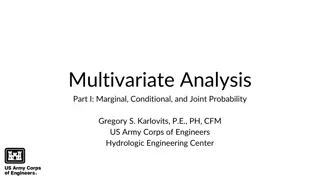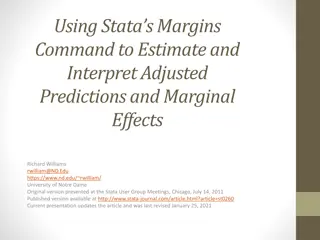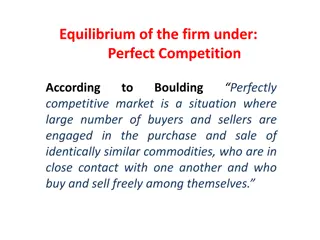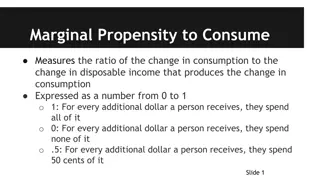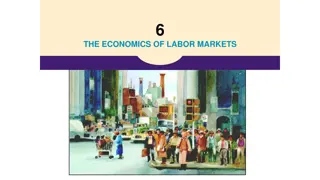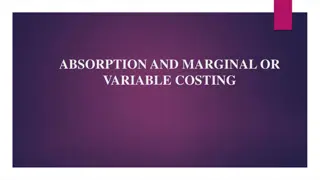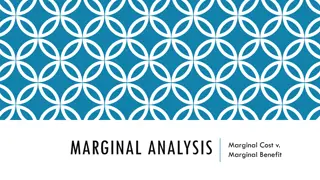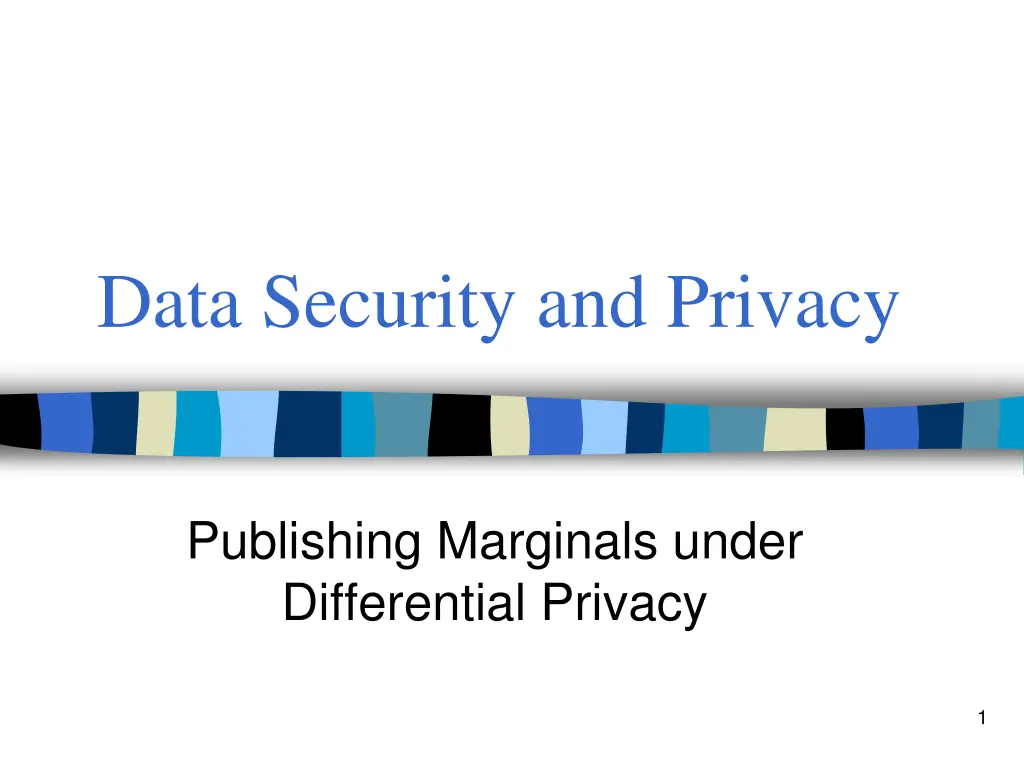
Differential Privacy in Publishing Marginal Datasets
Explore the challenges of publishing high-dimensional data under differential privacy. Learn about decomposing joint distributions, answering marginal queries, utility metrics, and methods for constructing k-way marginal tables with reasonable accuracy. Discover how to ensure data security and privacy while preserving data integrity.
Download Presentation

Please find below an Image/Link to download the presentation.
The content on the website is provided AS IS for your information and personal use only. It may not be sold, licensed, or shared on other websites without obtaining consent from the author. If you encounter any issues during the download, it is possible that the publisher has removed the file from their server.
You are allowed to download the files provided on this website for personal or commercial use, subject to the condition that they are used lawfully. All files are the property of their respective owners.
The content on the website is provided AS IS for your information and personal use only. It may not be sold, licensed, or shared on other websites without obtaining consent from the author.
E N D
Presentation Transcript
Data Security and Privacy Publishing Marginals under Differential Privacy 1
What About High-Dimensional Data? Histogram publishing would not work It is infeasible to publish joint-distribution of all dimensions simultaneously Solutions: Decompose the joint distribution into many smaller distribution Similar in spirit to Probabilistic Graphical Models Figure out which dimensions one cares about As when mining frequent itemsets 2
Outline Background and motivation PriView: Practical Differentially Private Release of Marginal Contingency Tables To appear in SIGMOD 2014 PrivBasis: Mining Frequent Itemsets with Differential Privacy In VLDB 2012. 3
Answering Marginal Queries: Problem Definition Given a d-dimensional binary dataset D, and a positive integer k < d, we want to differentially privately construct a synopsis of D, so that any k- way marginal table can be computed with reasonable accuracy Assume d is large, e.g., between 30 and 200 And k is small, e.g., between 2 and 8 4
Relational Table Name Gender Age Income Alice Bob Carlos Dan Eve Frank Female Male Male Male Female Male 31 28 30 45 19 24 150k 100k 110k 200k 50k 40k 5
Contingency Table Gender Male: 1 Female: 0 Age Income More than 100k: 1 Otherwise: 0 Larger than 25: 1 Otherwise : 0 Count 0 0 0 0 1 1 1 1 0 0 1 1 0 0 1 1 0 1 0 1 0 1 0 1 1 0 0 1 0 1 0 3 6
From Contingency Table to Marginal Tables Gen Age Cnt 0 0 1 Gen Age Inc Cnt 1 0 0 1 0 1 0 3 0 1 1 0 0 0 0 1 1 1 1 0 0 1 1 0 0 1 1 0 1 0 1 0 1 0 1 1 0 1 1 1 3 Gen Cnt 0 2 1 4 7
Utility Metrics Utility: the generated k-way marginal should be close to the true values Sum of Squared Errors (SSE) Jensen-Shannon divergence 8
A Middle Ground Publish a set of Views, each of size more than k and less than d E.g. d = 16, k = 2 Publish six 8-way marginal tables ensures that every pair is covered by one marginal {1-4,5-8}, {1-4,9-12}, {1-4,13-16}, {5-8,9-12}, {5-8, 13-16}, {9-12,13-16} Result in less noise than either direct or flat 10
PriView: The Steps 1. Choose the set of view coordinates Each is a set of dimensions 2. Generate noisy marginals views Add Laplacian noise to marginals 3. Consistency step Make all noisy views consistent 4. Generate k-way marginals Inferring from the noisy views 11
Step 1: Choosing the set of view coordinates We use covering design to choose a set of view coordinates such that any set of t dimensions is covered by at least one view Parameters: t: balances noise errors and correlation errors Optimal choice depends on dataset properties; t=2 works well empirically in our experiments l: the number of dimensions in each view t and l determines the number of views 12
Step 1: Choose the parameters We estimate the ESE to be on the order of Conclusions: l should be around 8 13
Step 2: Generate Noisy Views For each set of dimensions, compute the corresponding marginal table, then add Laplace noise to all cells Noise proportional to number of views The only step in PriView that needs direct access to the dataset. 14
Step 3: Consistency Step Perform constrained inference on the marginal tables Ensures that any two noisy views are mutually consistent Has two benefits: improve accuracy and enables query answering (step 4) In each step, ensures a set of views consistent on their intersection Use topological sort to decide ordering of steps 15
Step 3: Non-negativity and Consistency Negative number doesn t make sense Change negative numbers to zero introduces a bias and destroys consistency Our approach: Ripple non-negativity: Turns negative counts into 0 while decreasing the counts for its neighbors to maintain overall count unchanged Consistency + Non-negativity + Consistency 16
Step 4: Compute k-way Marginals Maximum Entropy The probability distribution which best represents the current state of knowledge is the one with largest information-theoretical entropy 17
Experiment Datasets Dataset Dimension Number of records 912,627 Kosarak 32 AOL 45 647,377 MSNBC 9 989,818 MCHAIN 64 1,000,000 18
Other Methods Data Cube2 Matrix Mechanism3 Multiplicative Weights Mechanism4 Learning Based Approaches5 Flat Method Direct Method Fourier Method1 1. B. Barak, K. Chaudhuri, C. Dwork, S. Kale, F. McSherry, and K. Talwar. Privacy, accuracy, and consistency too: a holistic solution to contingency table release. In PODS 07, pages 273 282, 2007. 2. B. Ding, M. Winslett, J. Han, and Z. Li. Differentially private data cubes: optimizing noise sources and consistency. In SIGMOD, pages 217 228, 2011. 3. C. Li and G. Miklau. An adaptive mechanism for accurate query answering under differential privacy. PVLDB, 5(6):514 525, Feb. 2012. 4. M. Hardt, K. Ligett, and F. McSherry. A simple and practical algorithm for differentially private data release. In NIPS, pages 2348 2356, 2012. 5. J. Thaler, J. Ullman, and S. Vadhan. Faster algorithms for privately releasing marginals. In ICALP, pages 810 821, 2012. 19
Fourier Method Starting from Direct Method; tries to solve the inconsistency problem Instead of publishing noisy marginals, publishes noisy Fourier coefficients for constructing the marginals Any set of Fourier coefficients correspond to a full contingency table; however, the one corresponding to perturbed Fourier coeffcients may contain non- negative/non-integral values Linear programming can be used to find an integral contingency table close to perturbed coefficients 1. B. Barak, K. Chaudhuri, C. Dwork, S. Kale, F. McSherry, and K. Talwar. Privacy, accuracy, and consistency too: a holistic solution to contingency table release. In PODS 07, pages 273 282, 2007. 22
Limitations of the Fourier Method Same accuracy for marginal queries compared with Direct method Linear program step solves for 2^d variables, can be carried out only when d is small When d is small, using Flat is pretty good 23
Learning Based Method Given a set of counting queries indexed using {0,1}L, a dataset D can be viewed as a function fD on L binary variables And fD can be viewed as sum of fx for each x D For each tuple x D, compute a polynomial f x approximating fx using the Chebyshev polynomials. Compute f D by summing up all f x and add Laplace noise to coefficients J. Thaler, J. Ullman, and S. Vadhan. Faster algorithms for privately releasing marginals. In ICALP, pages 810 821, 2012. 24
Limitation of Learning-Based Methods Most mathematically interesting among the methods Becomes computationally expensive when d>9 While asymptotic analysis shows that its accuracy is better than Direct, this occurs only when k>60 (recall that we are issing k-way marginal queries) 25
Multiplicative Update Starts with an initial full contingency table that is uniform, and then selects, using the exponential mechanism, a k-way marginal that is most incorrectly answered by the current distribution. One then obtains a noisy answer to the selected marginal, and updates the distribution to match the current state of knowledge. This process is repeated T times. M. Hardt, K. Ligett, and F. McSherry. A simple and practical algorithm for differentially private data release. In NIPS, pages 2348 2356, 2012. 26
Limitations of PriView Requiring covering every pair of dimensions does not scale to higher dimensions With higher number of dimensions, one needs to choose which sets of dimensions to focus on Or decides not to cover all pairs, e.g., using randomly generated views Utility depends on nature of dataset 27
Membership Privacy: A Unifying Framework For Privacy Definitions Ninghui Li Department of Computer Science and CERIAS Purdue University Joint work with Wahbeh Qardaji, Dong Su, Yi Wu, Weining Yang 28
Two Versions of Differential Privacy Unbounded differential privacy Two datasets are neighboring if one is obtained by adding one tuple to the other dataset One has n tuples, one has n-1 tuples Bounded differential privacy Two datasets are neighboring if one is obtained by replacing a tuple with another tuple Both have the same number of tuples 29
Need for a General Privacy Framework Desire to relax differential privacy Differential privacy under sampling [Li et al. 2012] A series of papers challenging differential privacy Differential privacy is not robust to arbitrary background knowledge (Kifer and Machanavajjhala 2012) Difficult to choose in DP, propose differential identifiability (Lee and Clifton 2012) Differential privacy does not prevent attribute disclosure (Cormode 2012) 30
Why Membership Privacy? Privacy incidents demonstrate Privacy violation = positive membership disclosure No membership disclosure means no attribute disclosure and no re-identification disclosure Membership privacy = Protect any tuple t s membership in input dataset 31
Formalizing Membership Privacy Adversary has some prior belief about the input dataset (modeled by a prob. dist. over all possible datasets) Gives the prior probability of any t s membership Adversary updates belief after observing output of the algorithm, via Bayes rule Obtains posterior probability of t s membership For any t, posterior belief should not change too much from prior Whether this holds may depend on the prior distribution Membership privacy is relative to the family of prior distributions the adversary is allowed to have 32
Positive Membership Privacy E.g., =1.25, when Pr[t T]=0.8, Pr[t T | A(T) S] min(0.8*1.25, 1-0.2/1.25) when Pr[t T]=0.2, Pr[t T | A(T) S] min(0.2*1.25, 1-0.8/1.25) = min(1,1-0.16) = 0.84 33 = min(0.25, 1-0.64) = 0.25
Negative Membership Privacy Positive membership privacy bounds the ability to conclude a tuple t is in the input dataset; it is allowed to conclude that a tuple t is not in the dataset Negative membership privacy is analogously defined to bound the increase in posterior probability that a tuple is not in the dataset 34
Results from Membership Privacy Membership privacy for the family of all possible distributions is infeasible Requires publishing similar output distributions for two completely different datasets Output has (almost) no utility Moral: One has to make some assumptions about the adversary s prior belief Assumptions need to be clearly specified and reasonable 35
Differential Privacy as Membership Privacy Unbounded differential privacy is equivalent to (positive + negative) membership privacy under the family of all Mutually Independent (MI) distributions Each MI distribution can be written as Pr[T] = t T pt t T (1-pt) where there is pt for each t Bounded differential privacy is equivalent to (positive + negative) membership privacy under the family of all distributions obtained by restricting MI distributions to allow only distributions of a fixed length Differential privacy insufficient for membership privacy without independence assumption 36
Differential Identifiability [Lee & Clifton 2012] as Membership Privacy Intuition: For each t, posterior membership prob bounded by , assuming prior is such that t can be replaced with any tuple not already in T Equivalent to positive membership privacy for a sub-family of that corresponding to bounded differential privacy 37
A New Privacy Notion Membership privacy under the single uniform distribution (each tuple has prob 0.5) is a new notion that enables better utility max can now be answered with high accuracy 38
Membership Privacy Notions We Considered All distributions: Privacy with Almost no Utility Bounded Mutually Independent dist.: MI distributions conditioned on all datasets have the same size Bounded Differential Privacy Mutually Independent (MI) dist: Pr[T] = t T pt t T (1-pt) Unbounded Differential Privacy MI distributions where each pt is either 1 or 1/m, where m is number of t s have probability 1 Differential Identifiability MI distributions where each pt is either 0 or Differential Privacy Under Sampling MI distributions where each pt is 1/2 New privacy notion 39
Other Related Work Pupperfish privacy [Kifer & Machanavajjhala 2012] Require specifying a set of potential secrets, set of discriminative pair of DBs Generalizes DP to allow defining which pairs of DBs result in close output distribution Coupled-world privacy [Bassily et al. 2013] Require D and D_t result in close output distribution, where D is drawn from some distribution 40
Conclusions We have introduced membership privacy framework Motivated by real-world privacy incidents Captures what the society views as privacy violations Membership privacy framework improves analyzing/understanding existing notions Membership privacy framework provides a principled way to define new privacy notions for better privacy/utility tradeoff 41

